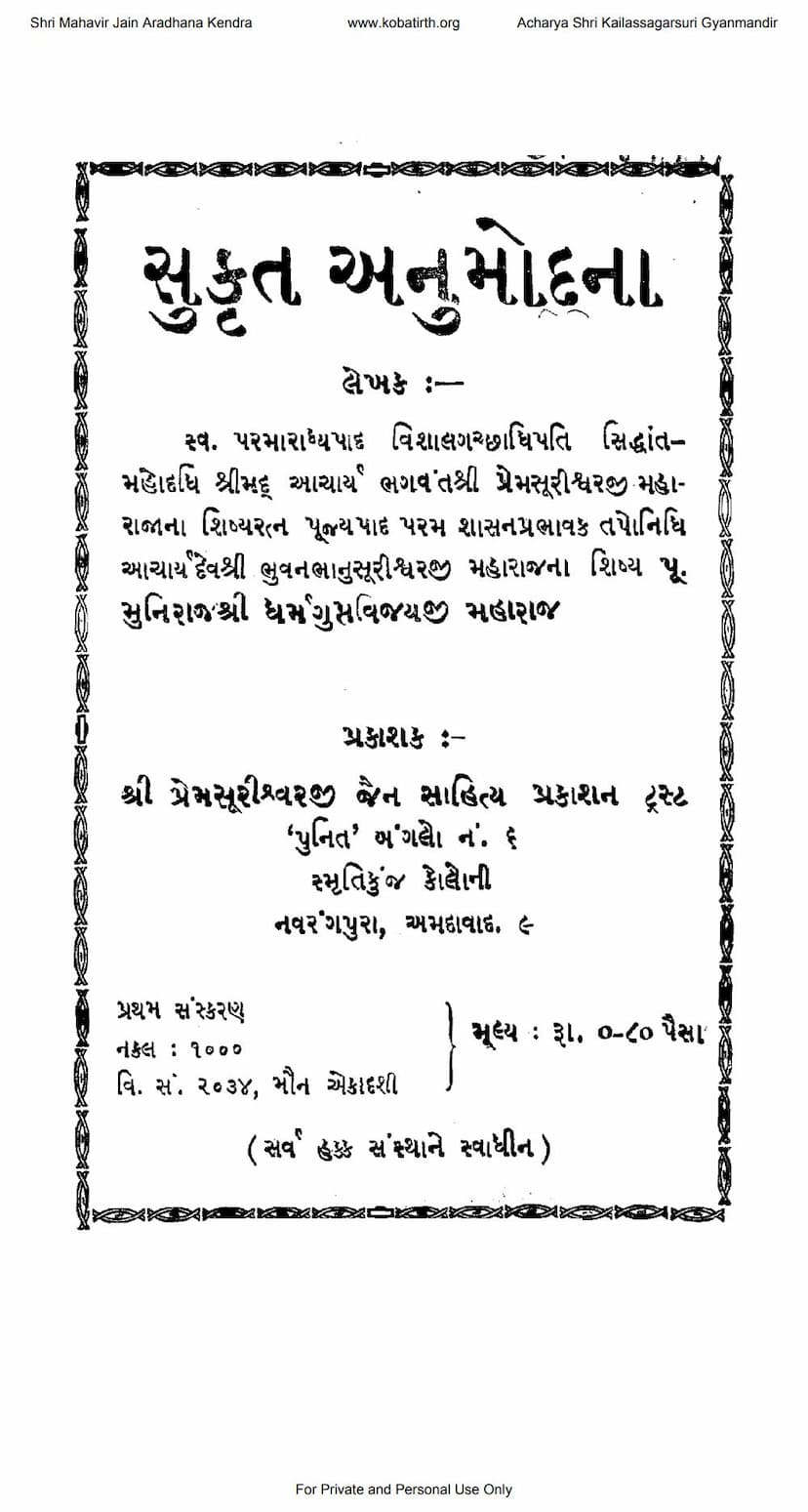Sukrut Anumodna
Added to library: September 2, 2025

Summary
Here is a comprehensive summary of the Jain text "Sukrut Anumodna" by Dharmguptavijay:
The book "Sukrut Anumodna" (Approval of Good Deeds) by Muni Rajshri Dharmguptavijay, published by Shri Premsuri Jain Sahitya Prakashan Trust, is a profound treatise on the importance and essence of "Anumodna" (rejoicing in and approving of good deeds) in Jainism.
Core Concept of Sukrut Anumodna:
The central theme of the book is that Anumodna is the root of all religions and the secret of all scriptures. The author emphasizes that those who do not practice Anumodna have not truly entered the path of Dharma. The foundation of genuine Anumodna lies in a deep-rooted love and appreciation for good deeds. Without this sincere affection, true Anumodna cannot be achieved.
The Primacy of Anumodna:
The text quotes the Shrutak (Shatak Granth) stating: "Karan-karananumodanahya, trishu-tvapi anumedanaiva pradhana!" This means that out of the three actions – performing a good deed (karan), causing others to perform a good deed (karan), and approving of good deeds (anumodna) – Anumodna is the most important.
The reasoning provided is that while performing a good deed might be done out of fear, greed, or shame, and causing good deeds might be done for public acclaim or honor, Anumodna is solely motivated by a deep-seated love and respect for the virtuous act itself. Therefore, Anumodna is presented as a pure form of Dharma, a guaranteed religious merit, whereas the other two actions may or may not yield true Dharma.
The Nature and Benefits of Anumodna:
- Joyful and Inspiring: Anumodna is described as a source of happiness and enthusiasm for performing good deeds. Witnessing or hearing about the virtuous actions of others brings immense joy.
- Ladder to Siddhi: It is considered the stairway to spiritual attainment (Siddhi) and the bedrock of all religious practices.
- Mother of All Virtues: Anumodna is portrayed as the mother of all good deeds and the most excellent means to earn merit.
- Subtle and Pure Path: It is a simple, subtle, and pure path to achieving spiritual goals.
- Mental Sadhana: Anumodna is considered a "mental Dharma," highlighting the significance of inner practices. Even if unseen or unknown by the world, this practice, like a secret mantra, holds immense value. It is the best messenger for the soul towards liberation.
Anumodna as a Result of Disgust for Wrongdoing:
The book explains that a strong aversion to evil deeds (Dushkrit) naturally gives rise to love and partiality towards good deeds (Sukrit). As the dislike for wrongdoing increases, so does the love for virtuous actions. Complete renunciation of evil leads to complete devotion to good, which signifies that spiritual liberation is not far off.
The Genesis of the Book:
The author reveals that the book itself was born from the continuous practice of "Sukrut Anumodna." One day, while engaging in this practice and experiencing inner bliss, the author felt a desire to share this great benefit with others who might lack scriptural knowledge or the ability to introspect effectively. Thus, the book was created to provide a verbal form of this practice.
Extensive List of Praiseworthy Individuals and Actions (Pages 5-28):
The majority of the book is dedicated to an extensive list of benedictions or "Dhanya Chhe" (Blessed are...) statements. These passages praise numerous individuals throughout Jain history and tradition for their virtuous deeds, renunciations, austerities, and devotion. The list includes:
- Tirthankaras and their lineage: Rishabhdev Bhagwan, his sons, and their lineage.
- Key disciples and Ganadharas: Gautam Gandhar, Jambuswami, Prabhuvwami, etc.
- Renowned monks and nuns: Dhanna Angar, Sholibhadra, Lavanyakartar, Prasannachandra Rajarshi, Abhaykumar, Chandanbala, Mrigavati, Aryarakshit Suri, Shyyambhav Suri, Sthulibhadra, Vajrakumar, Haribhadra Suri, Hir Suri, Jagadchandra Suri, Kakkalsur, Hemchandra Suri, etc.
- Devout laypeople: Vastu-Tejpal, King Kumarpal, Vikramsha, Jagadushah Seth, Samprati Raja, Karmashah, Vipra Bhadra, King Shripal and Mayana Sundari, Punia Shravak, Bahubali, Nandi Sen, etc.
- Satijis (virtuous women): Chandanbala, Mrigavati, Satipati, Subhadra, Madanrekha, etc.
- Individuals who performed significant acts of devotion, sacrifice, and adherence to vows: Including those who endured extreme hardships, performed severe austerities (like Ayambil), protected the Dharma, and attained Keval Gyana (omniscience) or attained higher realms.
The sheer volume of these examples underscores the author's intent to showcase a wide spectrum of virtuous conduct and inspire the reader to feel joy and reverence for these acts.
Key Themes Emphasized Through Examples:
- Renunciation (Tyag): Many examples highlight the sacrifice of worldly pleasures, wealth, and relationships for the sake of spiritual pursuit.
- Austerity (Tap): The text frequently praises those who undertook severe penances and fasts.
- Ahimsa (Non-violence): The importance of ahimsa is evident in many narratives, including those of kings who promoted it.
- Devotion (Bhakti): Devotion to the Tirthankaras, Gurus, and the Jain teachings is a recurring theme.
- Conduct (Charitra): The strict adherence to vows and the principles of Jain conduct is celebrated.
- Courage and Steadfastness: Many stories illustrate the resilience of individuals in the face of adversity, persecution, and temptation.
- Compassion (Daya) and Forbearance (Kshama): These virtues are highlighted in the actions of many individuals.
- Wisdom and Knowledge (Gyan): The pursuit and dissemination of knowledge are also praised.
Conclusion:
"Sukrut Anumodna" is a powerful call to embrace the practice of rejoicing in and appreciating the good deeds of all beings. The book emphasizes that this seemingly simple act is a fundamental pillar of Jain Dharma, leading to spiritual progress and ultimate liberation. The extensive list of exemplary figures serves as a rich source of inspiration and a testament to the profound virtues that can be cultivated through a life dedicated to righteousness. The book concludes with a final affirmation of the blessedness of all those who live a life of purity, devotion, and adherence to the Jain path.